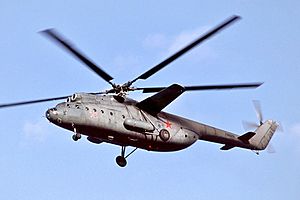Mil Mi-6 facts for kids
class="infobox " style="float: right; clear: right; width: 315px; border-spacing: 2px; text-align: left; font-size: 90%;" ! colspan="2" style="text-align: center; font-size: large; padding-bottom: 0.3em;" | Mi-6 |-
|- | colspan="2" style="text-align: center;" |  |- |colspan="2" style="border-bottom: 1px solid #aaa;text-align:center;" |A Mil Mi-6 of Soviet Air Forces in flight |-
|- |colspan="2" style="border-bottom: 1px solid #aaa;text-align:center;" |A Mil Mi-6 of Soviet Air Forces in flight |-
! Role | Heavy transport helicopter |-
! Manufacturer | Mil Moscow Helicopter Plant |-
! First flight | 5 June 1957 |-
! Retired | 2002 (Russia CAA) |- ! Status | Retired from service |- ! Primary users | Soviet Air Force (historical)
Aeroflot (historical) |- ! Produced | 1959–1980 |- ! Number built | 926 |-
! Variants | Mil Mi-10 |-
|} The Mil Mi-6 (Russian: Мил Ми-6), also called the Hook by NATO, was a huge transport helicopter. It was designed in the Soviet Union by a company called Mil. This helicopter was one of the biggest and most powerful helicopters of its time. It was built to carry very heavy loads, both for military and civilian uses.
Contents
What Was the Mil Mi-6?
The Mil Mi-6 was a special type of helicopter known as a heavy transport helicopter. This means it was designed to lift and move extremely heavy items. It was one of the first helicopters in the world to have powerful turboshaft engines. These engines helped it lift more weight than many other aircraft.
A Giant in the Sky
When the Mil Mi-6 first flew in 1957, it was the largest helicopter in the world. It was truly a giant in the sky! This helicopter was so big that it could carry up to 120 passengers. It could also carry large vehicles or equipment inside its cargo hold. Its massive size and lifting power made it very useful for many different jobs.
What Was It Used For?
The Mil Mi-6 was used for many important tasks. It served both the military and civilian groups. Its main job was to transport heavy cargo and troops.
Military Missions
In the military, the Mi-6 was a workhorse. It could quickly move soldiers and their gear across long distances. It also carried large military vehicles, like trucks or even small armored cars. This helped armies move supplies and people quickly, especially in places without good roads.
Helping Civilians
Outside of the military, the Mi-6 was just as important. It helped with many civilian projects. For example, it was used to transport equipment for oil and gas exploration. It also helped build power lines and bridges in remote areas. Sometimes, it even helped carry large parts for other construction projects. Its ability to lift heavy items to hard-to-reach places made it very valuable.
How Was It Designed?
The Mil Mi-6 had a unique design that helped it carry heavy loads. It had two large turboshaft engines mounted on top of its fuselage. These engines powered a huge main rotor. It also had small wings on its sides. These wings helped create extra lift when the helicopter was flying forward. This made it more efficient and allowed it to carry even more weight.
Where Are They Now?
The Mil Mi-6 was produced from 1959 to 1980. Over 900 of these powerful helicopters were built. They served for many years in various countries. However, as newer and more modern helicopters were developed, the Mi-6 slowly began to retire. The last ones were officially retired from service in Russia around 2002. Today, some Mi-6 helicopters can still be seen in museums. They stand as a reminder of a time when they were the kings of heavy lifting in the sky.
Images for kids
-
A Mi-6 at Riga, Latvia
-
Egyptian Air Force Mil Mi-6 on display at the Air Force museum in Almaza Air Base, Cairo.
-
A Mil Mi-6 of Aeroflot at the 1965 Paris Air Show
See also
 In Spanish: Mil Mi-6 para niños
In Spanish: Mil Mi-6 para niños






